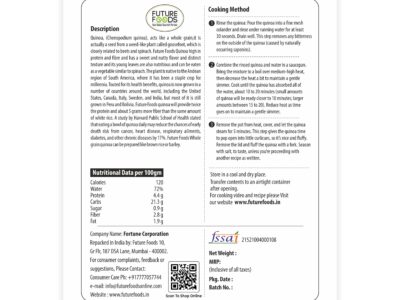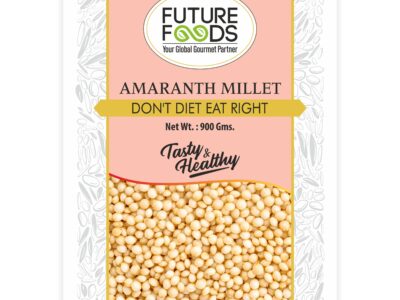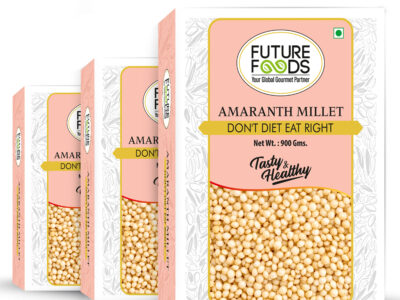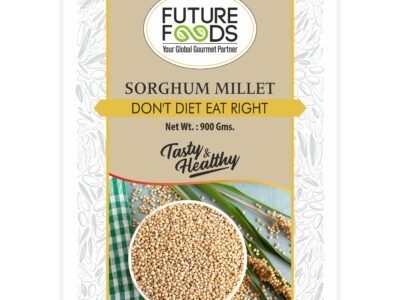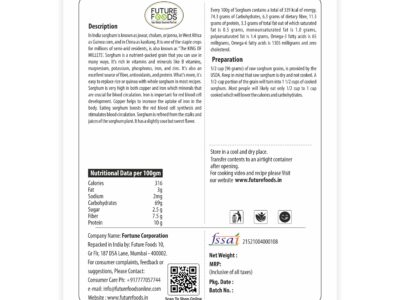Future Foods Premium Barnyard Millet | Jhangora/Sanwa | Gluten Free | Good Source of Protein & Fiber | With More Iron & Zinc Content | Ideal for Celiac & Diabetes Patients
1. Barnyard millet grain is a good source of protein, carbohydrate, fiber, and, most notably, contains more micronutrients (iron and zinc) than other major cereals. Despite its nutritional and agronomic benefits, barnyard millet has remained an underutilized crop.
2. Other Names Of Barnyard Millet - Jhangora , Sanwa , Kuthiravali (Kuthiraivolly), Udalu, Kodisama, Oodalu, Kavadapullu, Swank, Shyama Khira Cereals.
3. Barnyard millet is gluten-free and can be incorporated into the diet of celiac and diabetic patients.
Future Foods Premium Black Quinoa | Whole Grain | Sweet & Nutty Flavor | Gluten Free | Plant-Based Source of Protein | High Fiber & Protein
1. Unique Appearance: Black quinoa stands out for its striking dark color, ranging from deep purple to dark brown, adding visual appeal to dishes.
2. Nutritional Powerhouse: Like other quinoa varieties, black quinoa is a complete protein source, containing all nine essential amino acids, making it ideal for vegetarians and vegans.
3. Rich in Fiber: Black quinoa is high in dietary fiber, which supports digestive health, promotes satiety, and helps regulate blood sugar levels.
4. Abundance of Nutrients: Black quinoa is rich in essential vitamins (such as B vitamins), minerals (including iron, magnesium, and zinc), and antioxidants, contributing to overall health and well-being.
5. Earthy Flavor: Black quinoa has a slightly earthier flavor compared to white or red quinoa, adding depth to dishes and complementing a variety of ingredients and seasonings.
6. Culinary Versatility: Black quinoa can be used in a wide range of dishes, including salads, grain bowls, soups, and side dishes, offering versatility in culinary applications.
Future Foods Premium Rajgira/Amaranth Millet | Gluten Free | Nutrients Rich | Protein & Fiber Rich | Lowers Cholesterol | Rich in Antioxidants | Ideal for Halwa, Chikki & Ladoo
1. Nutritional Benefits: Both amaranth and millet are highly nutritious grains. They are rich in protein, fiber, vitamins (such as vitamin B6 and folate), and minerals (such as iron, magnesium, and phosphorus). These nutrients contribute to overall health and well-being./n1. Gluten-Free: Amaranth and millet are naturally gluten-free, making them suitable for individuals with celiac disease or gluten sensitivities./n1.
2. Versatility: Both grains are incredibly versatile and can be used in a wide range of dishes. They can be cooked as whole grains, ground into flour for baking, or popped like popcorn for a crunchy snack. Their mild flavors make them adaptable to various cuisines and cooking methods./n1.
3. Texture: Amaranth tends to have a slightly sticky texture when cooked, similar to porridge or polenta. Millet, on the other hand, has a light and fluffy texture when cooked, making it suitable for pilafs, salads, and side dishes./n1.
4. Culinary Uses: Amaranth and millet can be used in a variety of dishes, including porridges, soups, stews, salads, pilafs, and baked goods like bread, muffins, and cookies. They add texture, flavor, and nutritional value to recipes./n
5. Environmental Sustainability: Both amaranth and millet are considered resilient crops that require minimal water and resources to grow compared to some other grains. This makes them environmentally sustainable choices for both farmers and consumers
Future Foods Premium Red Quinoa | Whole Grain | Sweet & Nutty Flavor | Gluten Free | Plant-Based Source of Protein | High Fiber & Protein
1. Distinctive Color: Red quinoa is characterized by its vibrant reddish-brown hue, adding visual appeal to dishes and presentations.
2. Nutritional Powerhouse: Like other quinoa varieties, red quinoa is a complete protein source, containing all nine essential amino acids, making it an ideal option for vegetarians and vegans.
3. Rich in Fiber: Red quinoa is high in dietary fiber, which supports digestive health, promotes satiety, and helps regulate blood sugar levels.
4. Abundance of Nutrients: Red quinoa is packed with essential vitamins (such as B vitamins), minerals (including iron, magnesium, and zinc), and antioxidants, contributing to overall health and well-being.
5. Earthy Flavor: Red quinoa has a slightly earthier flavor compared to white quinoa, adding depth to dishes and complementing a variety of ingredients and seasonings.
6. Culinary Versatility: Red quinoa can be used in a wide range of dishes, including salads, pilafs, soups, and breakfast bowls, offering versatility in culinary applications.
Future Foods Premium Sorghum/Jowar Millet | High Protein | Gluten Free | Rich Source of Antioxidants | Dietary Fiber Rich | Ideal of Diabetic Patients | Supports Weight Control
1. Sorghum is known as jowar, cholam, or jonna/nIt's rich in vitamins and minerals like B vitamins, magnesium, potassium, phosphorus, iron, and zinc. It's also an excellent source of fiber, antioxidants, and protein.
2. Sorghum is very high in both copper and iron which minerals that are crucial for blood circulation.
3. Eating sorghum boosts the red blood cell synthesis and stimulates blood circulation.
Future Foods Premium Tri Quinoa | Whole Grain | Sweet & Nutty Flavour | Gluten Free | Plant-Based Source of Protein | High Fiber & Protein
1. Blend of Varieties: Tri-color quinoa is a blend of white, red, and black quinoa, combining the unique flavors, textures, and nutritional benefits of each variety.
2. Visual Appeal: The combination of white, red, and black quinoa creates a visually stunning blend, adding vibrant colors and visual interest to dishes
3. Nutritional Richness: Tri-color quinoa offers a diverse range of nutrients, including complete proteins, dietary fiber, vitamins, minerals, and antioxidants, contributing to overall health and well-being.
4. Flavor Profile: Each color of quinoa contributes its own distinct flavor profile - white quinoa adds a light and fluffy texture, red quinoa offers a slightly earthy flavor, and black quinoa provides a nutty taste and hearty texture.
5. Culinary Versatility: Tri-color quinoa is incredibly versatile and can be used in a variety of dishes, including salads, soups, pilafs, stir-fries, and baked goods, offering flexibility in culinary applications.
6. Quick Cooking: Similar to other quinoa varieties, tri-color quinoa cooks relatively quickly, typically requiring about 15-20 minutes, making it a convenient option for meal preparation.
Future Foods Premium White Quinoa | Whole Grain | Sweet & Nutty Flavor | Gluten Free | Plant-Based Source of Protein | High Fiber & Protein
1. Nutritional Powerhouse: White quinoa is a complete protein source, containing all nine essential amino acids, making it particularly beneficial for vegetarians and vegans.
2. Gluten-Free: As a seed, quinoa is naturally gluten-free, making it suitable for individuals with gluten sensitivities or celiac disease.
3. Versatility: White quinoa is incredibly versatile and can be used in a wide range of dishes, including salads, soups, stews, side dishes, and even baked goods.
4. Mild Flavor: White quinoa has a mild, nutty flavor that pairs well with various ingredients and seasonings, allowing it to adapt to different flavor profiles.
5. Delicate Texture: When cooked, white quinoa has a delicate texture with a slight crunch, adding a pleasing mouthfeel to dishes.
6. Sustainable Crop: Quinoa is a sustainable crop that thrives in diverse climates and requires minimal water compared to other grains, making it environmentally friendly.





